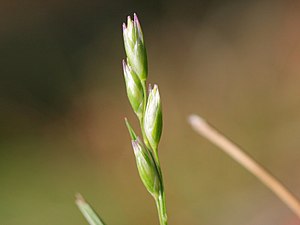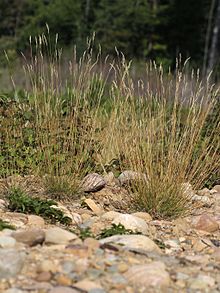Grape oat
| Grape oat | ||||||||||||
|---|---|---|---|---|---|---|---|---|---|---|---|---|

Trident ( Danthonia decumbens ) |
||||||||||||
| Systematics | ||||||||||||
|
||||||||||||
| Scientific name | ||||||||||||
| Danthonia | ||||||||||||
| DC. |
The grape oats ( Danthonia ) are a genus of grass from the sweet grass family (Poaceae). The genus is named after the French botanist and agronomist Étienne Danthoine (1739–1794), who researched the grasses of Provence in the 18th century .
features
The grape oats are perennial plants with sometimes long rhizomes . You are lawn-or Horst -bildend. The renewal shoots grow up inside or outside the lowest leaf sheaths . The stalks stand upright, seldom prostrate or kneeling-ascending. They have three to six nodes that are grooved and bare. The leaf sheaths are open to the base, grooved and glabrous to hairy. The ligula is a lash line. The leaf blade is flat to rolled up, narrow, mostly strongly grooved. The leaves are rolled in the bud position .
The inflorescence is a panicle , but can be reduced to a cluster (for example in Danthonia alpina ). It stands upright, contracted to spread out. The spikelets consist of 2 to 12 flowers, with the top floret usually reduced. The spikelets are up to 25 mm long, compressed on the sides. When ripe, the florets fall out individually, the glumes remain standing. The glumes are similar, 3 to 7-nerved, as long as the spikelet, membranous and acuminate. The lemmas usually have 9 nerves, are hairy, coarse-skinned and have two long teeth at the tip. In between there is a kneeling awn . The palea are two-veined, shorter than the lemma and have distinct, ciliate keels. There are three stamens . The ovaries are egg-shaped, glabrous and have two short, terminal styluses with feathery scars .
The caryopsis is glabrous and tightly enclosed by the husks. The embryo is elongated. The umbilicus is narrow-elliptical or line-shaped and takes a quarter to four fifths of the fruit length.
The vegetative organs store carbohydrates and fructans as a reserve .
distribution
The genus is common in the Holarctic and in the Neotropic . Their representatives grow in open locations, in grasslands and open forests, often in hilly areas.
Systematics
The genus Danthonia is placed within the family in the subfamily Danthonioideae and their only tribe Danthonieae. The genus consists of around 100 species.
The Kew Gardens grass database lists the following 26 species:
- Calyx oat ( Danthonia alpina Vest ): It occurs from Central and Southern Europe to the Caucasus.
- Danthonia annableae P.M. Peterson & Rúgolo : It occurs in Bolivia and northwestern Argentina.
- Danthonia araucana Phil . : It occurs in central and southern Chile.
- Danthonia boliviensis Renvoize : It occurs in Bolivia.
- Danthonia × breviaristata (Beck) Vierh. = Danthonia alpina × Danthonia decumbens : It occurs in Italy, France, the Czech Republic, Austria and Romania.
- Danthonia breviseta Hack. : It occurs in the Brazilian state of Rio de Janeiro .
- Danthonia californica Bol. : It occurs from western Canada to the western and central United States and also in central Chile.
- Danthonia cernua Döll : It occurs in southern Brazil.
- Danthonia chaseana Conert : It occurs in the Brazilian state of Minas Gerais .
- Danthonia chiapasensis Davidse : It occurs in southeastern Mexico.
- Danthonia chilensis É. Desv. : It occurs from Chile to western Argentina and the Juan Fernández Islands .
- Danthonia cirrata Hack. & Arechav. : It occurs from Bolivia to Brazil, Argentina and Uruguay .
- Danthonia compressa Austin : It occurs in Alaska and from eastern Canada to the eastern United States.
- Dreizahn ( Danthonia decumbens (L.) Lam. & DC. ): It occurs in Europe, from the Mediterranean to the Caucasus and in Macaronesia .
- Danthonia domingensis Hack. & Pilg. : It occurs in three subspecies in Hispaniola and Jamaica .
- Danthonia holm-nielsenii Laegaard : It occurs in Ecuador .
- Danthonia intermedia Vasey : It occurs in two subspecies from Canada to the United States and in Far Eastern Asian Russia.
- Danthonia malacantha (Steud.) Pilg. : It occurs in central and southern Chile and on the Juan Fernández Islands .
- Danthonia melanathera (Hack.) Bernardello : It occurs in northern Argentina.
- Danthonia montevidensis Hack. & Arechav. : It occurs from southern Brazil to Uruguay and northeast Argentina.
- Danthonia parryi Scribn. : It occurs from western and central Canada to the western and central United States.
- Danthonia rhizomata Swallen : It occurs from southern Brazil to Uruguay.
- Danthonia rugoloana Sulekic : It occurs in the province of Salta in Argentina.
- Danthonia secundiflora J. Presl : It occurs in two subspecies from Mexico to Guatemala and from western South America to Uruguay.
- Danthonia sericea Nutt. : It occurs from the eastern United States to Texas .
- Danthonia spicata (L.) Roem. & Schult. : It is widespread in North America.
- Danthonia unispicata (Thurb.) Munro ex Macoun : It occurs from western Canada to the western and central United States.
The following are no longer included in this category:
- Danthonia cachemyriana Jaub. & Spach => Tenaxia cachemyriana (Jaub. & Spach) NPBarker & HPLinder
- Danthonia cumminsii Hook. f. => Tenaxia cumminsii (Hook.f.) NPBarker & HPLinder
supporting documents
- Siegmund Seybold (Ed.): Schmeil-Fitschen interactive (CD-Rom), Quelle & Meyer, Wiebelsheim 2001/2002, ISBN 3-494-01327-6
- Walter Erhardt among others: The big pikeperch. Encyclopedia of Plant Names . Volume 2. Verlag Eugen Ulmer, Stuttgart 2008. ISBN 978-3-8001-5406-7
Individual evidence
- ↑ Lotte Burkhardt: Directory of eponymous plant names - Extended Edition. Part I and II. Botanic Garden and Botanical Museum Berlin , Freie Universität Berlin , Berlin 2018, ISBN 978-3-946292-26-5 doi: 10.3372 / epolist2018 .
- ^ Danthonia , in: L. Watson, MJ Dallwitz: The grass genera of the world . 1992ff.
- ^ Manfred A. Fischer , Karl Oswald, Wolfgang Adler: Excursion flora for Austria, Liechtenstein and South Tyrol. 3rd, improved edition. State of Upper Austria, Biology Center of the Upper Austrian State Museums, Linz 2008, ISBN 978-3-85474-187-9 .
- ↑ List of species , in: WD Clayton, KT Harman, H. Williamson: GrassBase - The Online World Grass Flora . 2006ff., Accessed July 27, 2008.
- ↑ a b c d e f g h i j k l m n o p q r s t u v w x y z aa ab ac Rafaël Govaerts (Ed.): Danthonia. In: World Checklist of Selected Plant Families (WCSP) - The Board of Trustees of the Royal Botanic Gardens, Kew . Retrieved November 17, 2016.



